
Mary Queen of Heaven newsletter – Term 3 – Week 7
24th August 2023
Dear families,
Recently I was invited to Kolbe Secondary College for their Feast Day Mass and the unveiling of their bronze statue of St Maximillian Kolbe. Listening to the story of this modern saint was a blessing. I felt honored and privileged to represent our school on this special occasion. Today’s prayer is dedicated to St Maximillian Kolbe.

Lord Jesus Christ, who said, “Greater love than this no man has that a man lay down his life for his friends,” through the intercession of St. Maximilian Kolbe whose life illustrated such love, we beseech you to grant us our desire to live out our school values of LOVE, RESPECT, HUMILITY and COURAGE just at Maximilian did.
Through the Militia of the Immaculata movement, which Maximilian founded, he spread a fervent devotion to Our Lady throughout the world. He gave up his life for a total stranger and loved his persecutors, giving us an example of unselfish love for all men, a love that was inspired by true devotion to Mary.
Grant, O Lord Jesus, that we too may give ourselves entirely without reserve to the love and service of our Heavenly Queen in order to better love and serve our fellowman in imitation of your humble servant, Maximilian. Amen.
St. Maximilian Kolbe was born as Raymond Kolbe on January 8, 1894, in the Kingdom of Poland, part of the Russian Empire. He was a Polish Conventual Franciscan friar and a martyr in the German death Camp of Auschwitz during World War II.
St. Maximilian Kolbe was very active in promoting the Immaculate Virgin Mary and is known as the Apostle of Consecration to Mary. Much of his life was strongly influenced by a vision he had of the Virgin Mary when he was 12.
“That night I asked the Mother of God what was to become of me. Then she came to me holding two crowns, one white, the other red. She asked me if I was willing to accept either of these crowns. The white one meant that I should persevere in purity, and the red that I should become a martyr. I said that I would accept them both.”
One year after his vision, Kolbe and his elder brother, Francis joined the Conventual Franciscans. In 1910, Kolbe was given the religious name Maximilian, after being allowed to enter the novitiate, and in 1911, he professed his first vows.
At the age of 21, Kolbe earned a doctorate in philosophy from the Pontifical Gregorian University. He would also earn a doctorate in theology by the time he was 28.
St. Maximilian Kolbe organized the Militia Immaculata (Army of the Immaculate One) after witnessing demonstrations against Pope St. Pius X and Benedict XV. His goal was to work for the conversion of sinners and enemies of the Church, specifically, the Freemasons and he would so with the intercession of Mary.
In 1918, he was ordained a priest and continued his work of promoting Mary throughout Poland. Over the next several years, Kolbe took on publishing. He founded a monthly periodical titled, “Rycerz Niepokalanej” (Knight of the Immaculate). He also operated a religious publishing press and founded a new Conventual Franciscan monastery at Niepokalanow, which became a major religious publishing center.
Kolbe also founded monasteries in both Japan and India. To this day, the monastery in Japan remains prominent in the Roman Catholic Church in Japan.
In 1936, Kolbe’s poor health forced him to return home to Poland, and once the WWII invasion by Germany began, he became one of the only brothers to remain in the monastery. He opened up a temporary hospital to aid those in need. When his town was captured, Kolbe was sent to prison but released three months later.
Kolbe refused to sign a document that would recognize him as a German citizen with his German ancestry and continued to work in his monastery, providing shelter for refugees – including hiding 2,000 Jews from German persecution. After receiving permission to continue his religious publishing, Kolbe’s monastery acted as a publishing house again and issued many anti-Nazi German publications.
On February 17, 1941, the monastery was shut down; Kolbe was arrested by the German Gestapo and taken to the Pawiak prison. Three months later, he was transferred to Auschwitz.
Never abandoning his priesthood, Kolbe was the victim to severe violence and harassment. Toward the end of his second month in Auschwitz, men were chosen to face death by starvation to warn against escapes. Kolbe was not chosen but volunteered to take the place of a man with a family.
It is said during the last days of his life Kolbe led prayers to Our Lady with the prisoners and remained calm. He was the last of the group to remain alive, after two weeks of dehydration and starvation. The guards gave him a lethal injection of carbolic acid. The stories tell that he raised his left arm and calmly awaited death.
St. Maximilian Kolbe died on August 14 and his remains were cremated on August 15, the same day as the Assumption of Mary feast day.
In recent weeks we have had so many wonderful school events. We celebrated our very first Mary Queen of Heaven Feast day with Father Dishan celebrating Mass for our community. On this day we acknowledged the amazing and inspiring woman Mary is and how blessed we are to have her as our school’s namesake. We hope all of our families loved the Mary Queen of Heaven tea light gift for your homes. The St Anastasia relic, gifted to us by Father Dishan was installed into our school altar on our Feast Day. A precious momento that adds to the sacredness of our school’s sacred space.
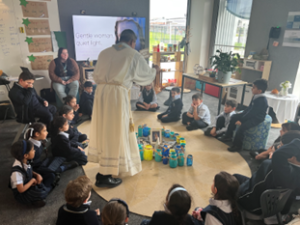
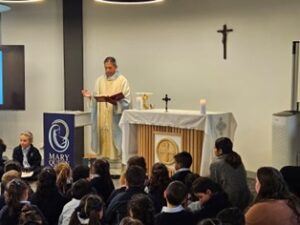
Krystina in year 5 undertook a selfless and generous gesture in cutting off her hair and donating it to make wigs for children who are undergoing treatment for cancer. Not only was this selfless, courageous and generous, it was a decision that Krystina made over three years ago. She has been growing her hair ever since. We could not be more proud of Krystina and the efforts she has made for those less fortunate than herself. We can all learn something from our amazing Social Justice Leader!


Colour Run
Our school colour run was a remarkable day filled with colour, fun and laughter. The participation from all was exceptional, and the fundraising efforts from our families was quite remarkable. Thank you for getting behind this fabulous day and ensuring it was a huge success for the children and for our community.

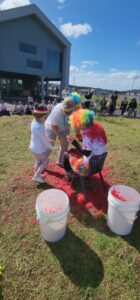




CONFIRMATION
We recently celebrated the Sacrament of Confirmation at Good Shepherd Parish. Our only candidate was Grace in year 6. She represented our school so beautifully, modelling our school values and the Gifts of the Spirit. We pray that the Holy Spirit will continue to inspire and guide Grace.

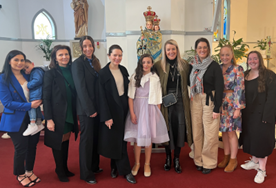
Congratulations to the following members of our community who will represent our School as part of our Parish School Advisory Board:
Jaclyn & Andrew Bouzikas
Vanessa & Peter Jurcic
Emma & Shaun Scott
Our three Parish Schools will come together to form a Parish Schools Advisory Board, a unique and effective structure for the betterment of all three schools in our parish.
Advisory in nature
The School Advisory Council provides a forum for discussion and discernment, where parent voice and community perspective are available to inform and support the decisions made by the principal and parish priest as the custodian of mission for the good of school and parish where students’ wellbeing and outcomes are paramount.
When used in this document, the term ‘parish priest’ will include priest moderator, parochial administrator, member of an association of canonical administrators or Archbishop’s nominee across primary or secondary contexts and designates their specific role in relation to schools and their title in reference to their ex-officio duties on a School Advisory Council, including their role as custodian of mission.
It is important that School Advisory Council members understand that their primary role is to provide assistance and advice on school matters to support the principal in their leadership role. School Advisory Councils do not have a legal identity and do not become involved in the day-to-day management of the school. The School Advisory Council must act within the parameters of this Terms of Reference.
The MACS board, as the governing body of MACS schools, is responsible for the common good of Catholic education in MACS schools in the Archdiocese, and thus is ultimately responsible for making any decision about the establishment of a council and its arrangements.
The following are some examples of the many ways the School Advisory Council may support the school and the principal:
- articulating and enacting the school’s vision and mission
- promoting the school’s Catholic ethos and culture
- promoting faith formation and development
- supporting school policies as required
- giving advice to the principal on issues such as school improvement plans and enrolment trends
- giving advice to the principal about the school master plan
- providing capital resource planning and maintenance support to the principal.
In my last newsletter I wrote about the importance of understanding Neurodiversity. The idea that there’s natural variation in how people’s brains work and how people experience, understand and interact with the world. This means there are natural differences in the way people learn and communicate. It has been wonderful to hear many parents chat to me about this and indicate their own learning about neurodiversity.
Upon enrolment at MQH, all families signed an Enrolment Agreement, a Parent Code of Conduct and a Student Code of Conduct. All of these documents are designed to ensure our communication is clear, our systems and processes are clear and most importantly, our children and families feel safe and included. It is the responsibility of all of us to abide by these policies so that our school can be the best we can offer. Please read over these policies (see website) to ensure all families are aware of what you have agreed to. I draw your attention particularly to our Student Behaviour Management Policy. Our approach to behaviour management is positive and restorative. We have 6 simple school rules that all of our learners are very well aware of. They know our continuum of response which begins with reminders and escalates to behaviour reflection sheets for ongoing or significant incidents. Please chat with your children about our approach so that you and your family are familiar with our approach. Importantly we need our families to trust us, know that we are always acting in the best interests of your children and that we share your role as educators of your children to ensure we assist them in all areas of learning, including behaviour.
One of the things we focus on when dealing with student behaviour is emotional regulation. Mindful practice and explicit teaching on how to manage ourselves forms part of our daily routine and informs our wellbeing lessons. Below (in the wellbeing) is some material you might like to chat with your child/ren about.
Wellbeing
Emotional Self-Regulation
Taking a few seconds to think things through before acting can make a huge difference in how a situation plays out. This is a skill most people can learn—it’s called self regulation.
People of any age can benefit from learning how to self-regulate their emotions. For kids, it’s a great way to learn how to control their impulses, make good social connections, and develop self-esteem. For adults, self-regulation makes stressful conditions at work, home, or in the community much more manageable.
Tantrums and outbursts are to be expected in toddlers and young children, but as they get older, kids usually get better and better at controlling their emotions. It is important for adults to model emotional regulation to children.
Some strategies we use at MQH for assisting with emotional regulation include:
- Recognising your own signs: This involves an awareness of how your own body communicates feelings (such as butterflies in the stomach).
- Scaffolding: Managing tasks that seem overwhelming by breaking them down into smaller more manageable steps.
- Mindfulness: This strategy helps to manage emotions through practical exercises such as deep breathing.
- Reframing the situation: This strategy involves thinking about a situation in a more positive way, rather than one that is likely to increase negative emotions.
- Zones of Regulation: This is a visual reference tool for students who have difficulty expressing emotions in words.
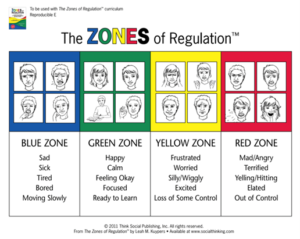
Loretta O’Dwyer
Learning Diversity Leader
Numeracy
Common mistake students make in counting

Have you ever noticed that when a child counts there are critical flash points that indicate if they have a deep understanding of the patterns within our number system?
In Prep you might see a child struggling with 44,45,46,47,48,49….(pause for 4 seconds)… 40 ‘ten’.
A common challenge for Year 1 and 2 students is: 107,108,109 (pause for 4 seconds)…200.
I wanted to share some of the strategies I use to help students to overcome this issue.
Firstly, I want to share with you a little about why this problem arises. Moving forwards or backwards over any place value part is challenging. We call this ‘bridging’. It is a skill students struggle with from very early in their counting journey, all the way through to Years 5 and 6 when they are required to count in decimal parts. Bridging requires a really deep understanding of the unit we are counting by and the counting pattern that underpins this count (this is closely related to an understanding of place value). Jumping from 109 to 200 is a common thinking mistake amongst novice counters. It is mostly because they haven’t generalised the idea that the 1-99 counting pattern repeats within each hundred.
I want to help them to see this pattern. So, once we get to 100, I then count alongside them… I say “1 hundred and” over and over as they count from 1-99 to help them see that it is the same pattern that they already know, except they have to say “one hundred and” in front.
In Australia, we include the ‘and’, so my instruction goes like this…
Me: One hundred and
Them: 1
Me: One hundred and
Them: 2
Me: One hundred and
Them: 3
Me repeating the same count (one hundred and) over and over, quickly helps them to see that the only thing that is different in the count from 100-199 is we need to say “one hundred and” in front of the numbers 1-99…
Then, if they get to 109…and get stuck you can say…
“What comes after 9? 10… ok. So put your ‘1 hundred and’ in front of ’10’ and keep the count going…”
We then move to do the same with numbers 200-300, then 300-400 etc.
Me: Two hundred and
Them: 1
Me: Two hundred and
Them: 2
Me: Two hundred and
Them: 3
Me: Two hundred and
Them: 4 etc
This all happens in one lesson because I want them to see the ‘big picture’ of counting. It is short, sharp, explicit instruction and it is one of my favourite lessons to teach as so many ‘light bulbs’ go on amongst children!
I walk into the lesson and say ‘by the end of today you will be able to count to 1000’. Many students look at me in disbelief, remembering how long it took them to learn how to learn to 99… but I say… maths is all about patterns, we are going to see the patterns today! When we help our students to be aware of the patterns, it is so powerful! Have a listen to how your child counts. Do they know how to bridge from one decade to another 149/150; 189/190?
What about when counting backwards? Can they see the pattern and understand that before decade numbers is 9 .. like 10, 9, 8, etc…. 20, 19, 18; 50, 49, 48; 169, 159, 158.
(Thanks to Dr Ange Rogers for her Blog on common mistakes in counting)
Dani De Luca
Numeracy Leader
In the coming weeks I will be taking some enrichment leave to travel to the Holy Land with 22 other principals from the Northern Region. We will be pilgrims following the ‘Footsteps of Jesus.’ I will be visiting The Dead Sea, Bethlehem, Jericho, Jerusalem, Hebron, Tiberius, Mount Carmel, Nazareth, Jordan and Petra. The Holy Land is an honour and a privilege to visit, I pray that this trip will further strengthen my faith and help me to gain a deeper understanding about the history, political landscape and religious significance of these Holy places.
Dani and Loretta will lead the school in my absence.

Please keep me and the other pilgrims in your prayers as we journey together:
In this busy world that we inhabit, grant us space to rest a while. By the still waters of your peace, to hear the whisper of your voice and felt the warmth of your breeze within our souls. Grant us space to rest a while. Amen.
Renae
School Fees for 2024
MARY QUEEN OF HEAVEN 2024 SCHOOL FEE STRUCTURE
SCHOOL FEES PER FAMILY – $2,000
See payable options below
- Payable IN FULL at the beginning of the year, DUE 16/2/2024
OR in three instalments as follows:
Term 1 DUE 16/2/2024 $667
Term 2 DUE 26/4/2024 $667
Term 3 DUE 12/7/2024 $666
MAINTENANCE LEVY PER FAMILY – $200.00 DUE 16/2/2024
This levy contributes towards the improvement and maintenance of our buildings and grounds.
STUDENT LEVY PER CHILD – $480 DUE 16/2/2024
The student levy covers all your children’s books and stationery requirements. It also covers the purchase of materials for different subject areas such as English, Maths, Inquiry, Library, Art, Computers and Physical Education etc.
EXCURSION/INCURSION LEVY PER CHILD – $80.00 DUE 16/2/2024
This will cover the cost of incursions and excursions. This will not be refundable should your child be away on the day of the excursion. Transport costs for the Year Six interschool sports are not included in the excursion levy. Children will be required to pay for these separately as the need arises.
SCHOOL CAMP PER CHILD (All Victorian based camps)
Year Five: TBA
Year Six: TBA

In this Issue: |
Upcoming Events |

